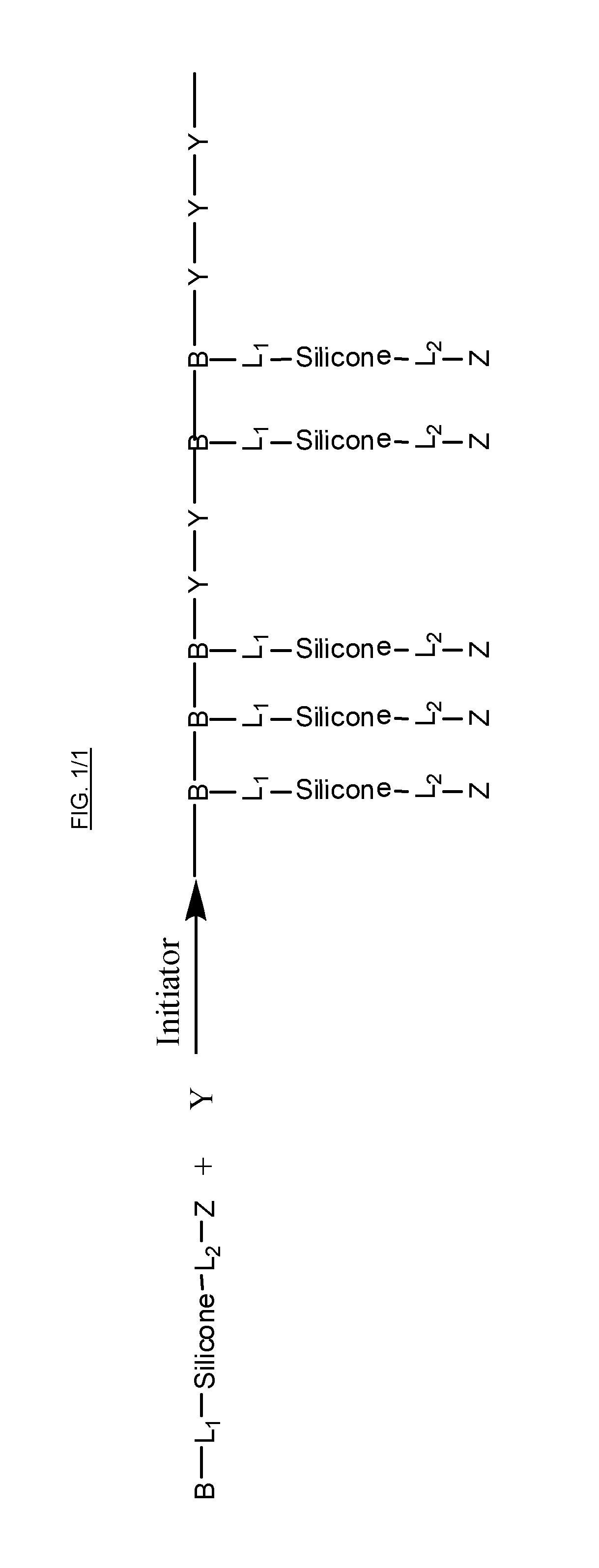Silicone containing monomers with hydrophilic end groups
a technology of hydrophilic end groups and monomers, which is applied in the direction of silicon organic compounds, group 5/15 element organic compounds, group 4/14 element organic compounds, etc., can solve the problems of lipids and proteins having a high tendency to deposit on a hydrophobic surface, affecting optical clarity, and affecting oxygen permeability, etc., to achieve good wettability and biocompatibility, and high oxygen permeability
- Summary
- Abstract
- Description
- Claims
- Application Information
AI Technical Summary
Benefits of technology
Problems solved by technology
Method used
Image
Examples
specific example 1
[0095]The process can be better understood by the non-limiting example given for the specific n, where n=2.
Step 1. Synthesis of Trimethylsiloxy Propyl Hexamethyl-Trisiloxane Monosilane
[0096]
[0097]Into a 500 mL three neck round bottom flask fitted with an additional funnel, nitrogen blanket, and thermal couple were charged hexamethyltrisiloxane (commercial sample from Gelest), anhydrous toluene and Wlkinson's catalyst (tris(triphenylphosphine)rhodium(I) chloride) and the flask was then heated in a 45° C. oil bath. Allyloxytrimethylsilane (commercial sample obtained from TCI America) was transferred into the additional funnel and was added drop-wise over a period of 1 hour into the flask. After the addition, the reaction mixture was stirred in the 45° C. oil bath overnight under nitrogen atmosphere and FT-IR suggested the complete consumption of allyoxytrimethylsilane. The crude product, which was a clear, colorless liquid, was fractionally distilled to isolate and collect the desired...
specific example 2
[0100]The same procedure was followed for the synthesis of terminal hydroxyl functional silicone methacrylate with a tetrasiloxane segment (n=3) using commercially available starting materials. H1 NMR: δ 6.11 (1H), 5.54 (1H), 4.26 (2H), 3.65 (2H), 3.55 (2H), 3.42 (2H), 1.92 (3H), 1.57 (4H), 0.51 (4H), 0.06 (12H), 0.00 (12H).
[0101]Other analogs of hydroxyl functional silicone methacrylate with a pentasiloxane segment (n=4) and a hexasiloxane segment (n=5) can be synthesized accordingly.
specific example 3a
[0102]The procedure as in specific Example 1 was followed for the synthesis of terminal di-hydroxyl functional silicone methacrylate with a tetrasiloxane segment (n=3) using the commercially available starting materials below. In this example, a TMS protected 3-allyl oxy-1,2-propanediol was used in replacement of allyoxytrimethylsilane. Upon de-protection, the final product methacryloxyethoxypropyl hexamethyl-trisiloxane propanoxy-1,2-propanediol was obtained.
PUM
| Property | Measurement | Unit |
|---|---|---|
| Polymer network | aaaaa | aaaaa |
| Hydrophilicity | aaaaa | aaaaa |
Abstract
Description
Claims
Application Information
 Login to View More
Login to View More - R&D
- Intellectual Property
- Life Sciences
- Materials
- Tech Scout
- Unparalleled Data Quality
- Higher Quality Content
- 60% Fewer Hallucinations
Browse by: Latest US Patents, China's latest patents, Technical Efficacy Thesaurus, Application Domain, Technology Topic, Popular Technical Reports.
© 2025 PatSnap. All rights reserved.Legal|Privacy policy|Modern Slavery Act Transparency Statement|Sitemap|About US| Contact US: help@patsnap.com



